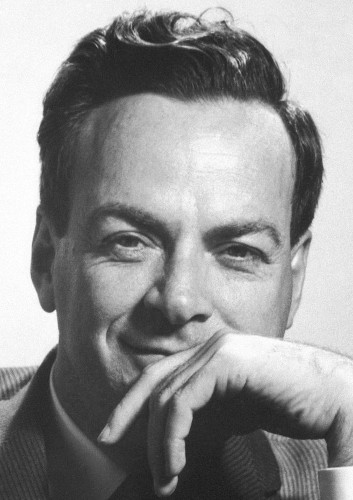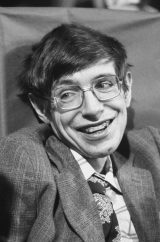 Bio
Bio
Richard Philips Feynman was born on the 11th of May, in the year of 1918, in Queens, New York City, New York, United States of America. Feynman was a notable and prominent American theoretical physicist, whose work on the topic of path integral formulation of quantum mechanics was great. Feynman was awarded the Nobel Prize in Physics in 1965.
As noted, Richard was born in Queens, New York City, to parents Melville Arthur Feynman, who was employed as a sales manager and had come from Minsk in Belarus, and mother Lucille, a homemaker. Feynman did not begin to speak before his third birthday, though he did go on to develop a rather thick New York accent.
Best Richard Feynman Books
Encouragement
When he was just a child, Feynman was encouraged by his father to pose questions that would challenge the common or traditional manner of thinking. The sense of humor that Lucille had was seemingly hereditary as Richard was noted for his own sense of humor, as well.
Perhaps the thing that most indicated what success Feynman would have later on in his life was when he, still in grade school, made a home burglar alarm system, all while his parents were running errands for the day. With that said, let’s see what the best Richard Feynman books are.
“Surely You’re Joking, Mr. Feynman!”

 Physics and Sciences
Physics and Sciences
“Surely You’re Joking, Mr. Feynman!” is one sincerely brilliant book from Feynman. The book is of an autobiographical nature and it was published in the year of 1985. The book’s page count is about four-hundred or so. It is one of the most popular Feynman books ever.
The book at hand by Feynman, a Nobel Prize laureate, is one that focuses on a plethora of things, never just one aspect of life, of a field, or of anything. With the markedly intense and charismatic humor that he is known for, Feynman takes a look at the physics of atoms, talks of Bohr and Einstein, talks gambling with Nick the Greek, and a load of other things on the topic of physics.
Diverse Thoughts
Other themes explored herein include safes that can’t be cracked, which safeguard secrets about nuclear weapons, bongo drumming and ballet, painting a nude toreador lady, and with many, many more some such quirky, fascinating walks of life being examined.
Feynman’s main goal with his writing is to say that data is never to be taken for granted, so that the sources should always be questioned, because if what we see as axioms are actually follies, then all will be lost. With the genuine lightheartedness that he is known for, Feynman wrote this book and we can’t recommend it enough.
“What do You Care What Other People Think?”

 Good at Everything
Good at Everything
“What do You Care What Other People Think?” is another fantastic book from Feynman, the second in the Feynman series. The book at hand is also autobiographical, as many of the Feynman books are, and it is among Richard Feynman’s best books.
One of the most important points in the book in question comes with the essay titled The Value of Science. It is here that Feynman showcases his wonderment of the world, whose intrinsic mystery he compares to the ones that certain religious experiences allow for. Feynman goes on to speak of uncertainty and how one can just as easily make a great contribution to the sciences while being oblivious of many other walks of life.
A Short Anecdote
Another key point has to do with Nasa and Feynman’s own curiosity. Being ever the man for posing the toughest of tough questions, Feynman was attending a press conference where certain things were being discussed, among which the safety regulations and safety claims of NASA were mentioned.
The figure was about one in ten thousand that a failure could happen, which once Feynman did the calculations, he was informed that it was more like one in a hundred, but bureaucracy held the decision.
Six Easy Pieces

 Easy Lessons
Easy Lessons
Six Easy Pieces is one of the most important Feynman physics books on the whole Richard Feynman books list. We consider the 1962 book to be one of the best Richard Feynman books, as well. Six Easy Pieces is a book which comprises of a total of six chapters, namely the easiest that Feynman ever taught, meant for the casual, non-scientific reader.
The first three of the book’s chapters deal with Atoms in Motion, with Basic Physics, and with the Relationship of Physics with Other Sciences. The chapters don’t just touch on the clear and cut physics aspect of things, but Feynman’s incorporation of a multitude of other themes is present here, too.
The Inner-Workings
Chapters four through six, on the other hand, have to do with Conservation of Energy, the Theory of Gravitation, and Quantum Behavior, which, in and of themselves, are denser and harder to grasp than the former three, but they’re even more fascinating.
A formula or two can be found here, as well, but nothing excessive and nothing that ought to deter a reader from finishing this marvelous volume. Can be also viewed as some of Richard Feynman’s books for kids.
QED: The Strange Theory of Light and Matter

 A Look at the Light
A Look at the Light
QED: The Strange Theory of Light and Matter is a very significant and important work of Feynman’s, one worthy of the moniker the Richard Feynman’s best book. The book was published in the year of 1985, spanning a bit over one-hundred-and-fifty pages.
The brilliant and very famous Nobel Prize laureate Feynman is known for a plethora of things, but being exceptionally curious and simplifying obscure, inaccessible topics to the general masses are two very relevant things regarding what he is known for. The book at hand is, in fact, a version of the four quantum electrodynamics lectures that Feynman carried out at UCLA. As the title is suggestive of, the book deals with quantum electrodynamics.
Heavy but Rewarding
QED, or Quantum Electro Dynamics, is the facet of quantum theory of fields which deals with the interactions and encounters of the quanta of electromagnetic field-light, gamma rays, x-rays, etc. with matter, and with these charged particles that interact with each other.
Utilizing the common everyday language along with Feynman’s knack for visualizing things, the book is very readable and easy to grasp once one has devoted sufficient time, which won’t be long. Among the best-selling Richard Feynman books out there.
The Pleasure of Finding Things Out

 The Man, The Myth
The Man, The Myth
One of the best-rated Richard Feynman books is unquestionably The Pleasure of Finding Things Out. The book is a veritable marvel to read and we recommend it wholeheartedly. It was published in 1999, spanning a bit under three-hundred pages.
For anyone unfamiliar with the works of Richard P. Feynman, the book at hand, we judge, would be a terrific first foray into both the mind and the life of the author. Popular talks of Feynman might have muddied the genuine outlook on the person, but once one gets this book and picks it up, the curious, charismatic, and enthusiastic character of Feynman has its grips on the reader and it won’t let go.
Author’s Passions
By means of a number of speeches and a number of essays, the reader gets a glimpse into the inner-workings of the brilliant mind of Feynman, with which one can get a better grasp on numerous scientific topics, but also the topic of life.
Talking about the first atomic bomb, the physicists like Einstein, Bohr, Fermi, and many others, along with parallel computing, nanotech, and so much more, Feynman’s earnestness is unwavering. Among the best books by Richard Feynman.
The Feynman Lectures on Physics

 Massive Volume
Massive Volume
The Feynman Lectures on Physics are perhaps the single most famous work out of all Richard Feynman’s famous books. The Feynman Lectures on Physics was published all the way back in the year of 1964, spanning a monstrous fifteen-hundred and plus pages, in total.
Digesting the Information
It is not an uncommon opinion or even an erroneous one to think that very few people will pick this volume up and buy it, then devote the requisite time needed to digest all of the information, of which there is an abundance, present herein. What makes the volume scary, of course, is the astonishing page count, though it doesn’t mean that one has to read through each and every page to get certain things; it is divided into lectures, so that should clear that up.
One Day at a Time
Of course, what makes the Feynman books such treats to read isn’t only the scientific information and insight that he brings to the table, but the casual, every-day, humane, and exceptionally pleasant manner of writing, which, when one is ready such a large book, makes things a lot easier to get through. This is one of the top Richard Feynman books, but also one of the most important works on the topic of science, ever.
Six Not-So-Easy Pieces

 Scientific Zeitgeist
Scientific Zeitgeist
Six Not-So-Easy Pieces can be viewed as the second part of the Six Easy Pieces book which is present among our Richard Feynman book reviews above. What sets this book apart is that it is a deeper jump into the scientific zeitgeist. The book at hand was published in 1963, spanning a tad under two-hundred pages. Out of all the Richard Feynman’s Lecture books, this is probably our favorite.
The Sequel
It is a known fact that of all the twentieth-century scientists coming from the USA, there are a very few that can possibly rival the popularity of Richard P. Feynman, who, in his day, was a true icon, both of the world of physics, but also of the pop-culture one. Following the Six Easy Pieces volume, this collection of six lectures is plucked straight out of the Richard P. Feynman lectures, but they are a bit denser than the former six.
Intriguing Concepts
At hand are six highly concentrated lectures, all of which delve deep into some of the most important topics of physics, beginning with the Theory of Relativity of Einstein, which was a tremendous breakthrough, one of the greatest in all of history.
Here, Feynman looks upon the time flow, which is not a constant, examines how an object’s mass can change depending on its speed, and how the speed of light is a constant, among a multitude of other scientific topics. Perhaps even the best Richard Feynman book.
The Meaning of It All

 The Why
The Why
Richard P. Feynman’s The Meaning of It All is a wonderful book, to say the least. Feynman’s volume here is one of his most enlightening, most touching, and most deeply honest. The volume was published in 1998, spanning a hair under one-hundred-and-fifty pages.
We are all surely aware that Richard P. Feynman is most famous for and most well known for having a number of contributions to the sciences, namely to physics, though to call that the only field with which Feynman concerned himself would be a grave and terrible disservice to both the man and the author. Feynman was, above all, a man that wanted to know and a man that was curious, but not just about the sciences.
Timely Views and Opinions
Feynman had a genuinely intriguing outlook on topics of politics, society, religion, and even the most important troubles in the social sphere, ones that are very relevant today.
Here, Feynman showcases us his sincerest side, the one that elaborates on the trouble between religion and society, that talks of politicians and why people don’t put their trust in them anymore, and even why certain unbelievable things are rather easy to believe in. A brilliant example of the author’s prowess and might.
The Character of Physical Law

 Masterpiece
Masterpiece
Taking a look at all the books written by Richard Feynman if one wants to get Richard Feynman’s books ranked in a certain order, for instance from best to worst, it would be a hard list to make without putting The Character of Physical Law towards the top. The Character of Physical Law was published in the year of 1964.
Brilliance of Nature
The Messenger Lectures were ones that first took place at Cornell University, which were also recorded for television by the BBC Network. It was in these lectures that Feynman gave an outlook and a summary of certain physical laws and how their commonalities can be grouped into one single, though very general invariance principle. Feynman doesn’t speak of human cleverness, but of the cleverness of nature and how it has such intriguing quirks, oddities, idiosyncrasies.
How It All Worked Out
With The Character of Physical Law, Feynman examines the most noteworthy aspects of nature, as something he revered. The approach that Feynman has to all topics, along with his enthusiastic, charming, and witty manner of storytelling, the volume that is being discussed becomes one of his most enlightening and most important ever. This is one book that we cannot recommend more to our readers – it is just that wonderful.
Perfectly Reasonable Deviations from the Beaten Track

 Revered Icon
Revered Icon
This book is a remarkable and immense volume, one that perfectly sums up the life and work of the great author and physicist. It was published in the year of 2004. The always untraditional and unorthodox lectures of Feynman surely added to the reputation and the mystique of the always curious, always finding out, and always quick to be witty author throughout his whole life.
Both students, teachers, and people from around the world knew of the kind of earnest, charming, and frivolous man that Richard P. Feynman was and it is an aspect of his disposition that very much defined him.
Close to the Heart
The present volume is a collection of letters, a number of which are being published for the very first time right here, where a certain aspect of Feynman can be seen for the first time. History, scientific developments, and a number of other more humane, more candid, and more personal topics are discussed by Feynman. A book that one would be making a terrible mistake if one passes up picking it up. Feynman Lectures on Computation is another book that we suggest taking a look at.
Michael Englert
Michael is a graduate of cultural studies and history. He enjoys a good bottle of wine and (surprise, surprise) reading. As a small-town librarian, he is currently relishing the silence and peaceful atmosphere that is prevailing.





